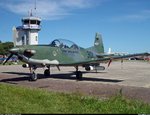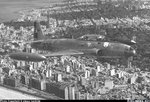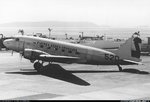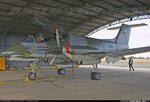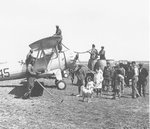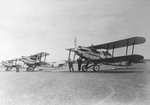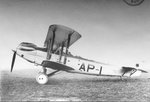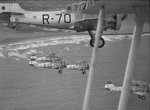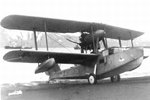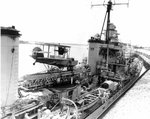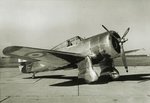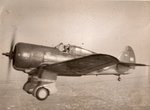- Thread starter
- #41
Navigation
Install the app
How to install the app on iOS
Follow along with the video below to see how to install our site as a web app on your home screen.
Note: This feature may not be available in some browsers.
More options
You are using an out of date browser. It may not display this or other websites correctly.
You should upgrade or use an alternative browser.
You should upgrade or use an alternative browser.
South American Air Forces
- Thread starter gekho
- Start date
Ad: This forum contains affiliate links to products on Amazon and eBay. More information in Terms and rules
More options
Who Replied?- Thread starter
- #42
Argentina was early in its development of a military air element. First usage of 'air power' took place in 1866 when balloons were used for aerial observation in the Guerra de la Triple Alianza (the war of triple alliance) against Paraguay. In those years the aerial demonstration scene was dominated by European daredevils never finding a big following by Argentineans until Christmas 1907 when the first take off was organised by Argentineans themselves. With a hot air balloon Aarón de Anchorena and Jorge Newbery managed to cross the River Plate to Uruguay, a feat that was never accomplished by Latin Americans before (although Americans had done it in 1887). This spurred aviation interest in Argentina. On 8 January 1908 the Aero Club Argentino was formed by a select group of enthusiasts putting Argentina in the forefront of Latin American aviation development. This led to the first motorised flight on 30 January 1910 (by Italian pilot Ricardo Ponzelli in a 50hp Voisin) and the inauguration of the first airfield on 23 March of the same year at Villa Lugano, Buenos Aires. The military showed increasing interest in aviation and the Aeroclub was tasked to integrate military aviation in the army. Eventually, the Escuela de Aviación Militar (military aviation school) was formed 10 August 1912 (later, in 1954, this became the official 'day of the air force').
El Palomar in the Campo de Mayo military area was adopted as the home base of military aviation. The early days saw a big influence from the Aeroclub, especially engineers Alberto Mascias and Jorge Newbery because the government simply lacked knowledge, funds and equipment. In honour of their achievements they were granted military aviator status before the first class of officers graduated. Jorge Newbery sadly died in a plane crash 1 March 1914, the Aeroparque airport of Buenos Aires is named after him. Involvement of the civil Aeroclub in military Aviation School ended in 1915 when the military was sufficiently trained to organise flight instruction and air operations renaming the school in Escuela Militar de Aviación in the process. The name reverted to Escuela de Aviación Militar again in 1944 and it is still known by that name today.
In 1919 the first Army air service was formed and after inception of the Grupo 1 de Observación in January 1922, the school was initially dissolved into this unit, but was re-instated in January 1925. After years of operating various small aircraft of European origin (Nieuports and Ansaldos for example), 1926 saw the arrival of about thirty Brequet XIV light bombers. Significant progress in Argentinean aviation was also achieved when on 10 October 1927 the Fábrica Militar de Aviones (FMA) was created at Cordoba. FMA started building Avro 504K, Dewoitine D21 and Curtiss 75 aircraft enabling the first international flight to Rio de Janeiro with FMA built aircraft in 1933. The military aviation school eventually relocated to Cordoba as well in 1937 and was re-equipped with the license built FW44J Stieglitz. Shortly after that a military passengers service was created with Ju-52 aircraft that eventually led to the formation of the air transport group in December 1941 at El Palomar. The first state airline was formed shortly after: Líneas Aéreas del Estado (LADE).
El Palomar in the Campo de Mayo military area was adopted as the home base of military aviation. The early days saw a big influence from the Aeroclub, especially engineers Alberto Mascias and Jorge Newbery because the government simply lacked knowledge, funds and equipment. In honour of their achievements they were granted military aviator status before the first class of officers graduated. Jorge Newbery sadly died in a plane crash 1 March 1914, the Aeroparque airport of Buenos Aires is named after him. Involvement of the civil Aeroclub in military Aviation School ended in 1915 when the military was sufficiently trained to organise flight instruction and air operations renaming the school in Escuela Militar de Aviación in the process. The name reverted to Escuela de Aviación Militar again in 1944 and it is still known by that name today.
In 1919 the first Army air service was formed and after inception of the Grupo 1 de Observación in January 1922, the school was initially dissolved into this unit, but was re-instated in January 1925. After years of operating various small aircraft of European origin (Nieuports and Ansaldos for example), 1926 saw the arrival of about thirty Brequet XIV light bombers. Significant progress in Argentinean aviation was also achieved when on 10 October 1927 the Fábrica Militar de Aviones (FMA) was created at Cordoba. FMA started building Avro 504K, Dewoitine D21 and Curtiss 75 aircraft enabling the first international flight to Rio de Janeiro with FMA built aircraft in 1933. The military aviation school eventually relocated to Cordoba as well in 1937 and was re-equipped with the license built FW44J Stieglitz. Shortly after that a military passengers service was created with Ju-52 aircraft that eventually led to the formation of the air transport group in December 1941 at El Palomar. The first state airline was formed shortly after: Líneas Aéreas del Estado (LADE).
Last edited:
- Thread starter
- #43
As can be read in the general military aviation history part, the flying units were still part of the army in 1940. The quest for independence gained momentum in the forties. A revolution in 1943 brought a lieutenant colonel from the aviation branch to power among others and the formation of the independent air force was imminent. Subsequently, Air Force command was formed 11 February 1944 and the secretary of Aeronautics on 4 January 1945. The air force also adopted its own badges and ranks in the intervening period. Although the structure was in place, much of the necessary infrastructure still needed to be created. Paved runways and both military and civil airfields were introduced and the late forties and early fifties saw an influx of modern aircraft. The Gloster Meteor was the first jet aircraft adopted in any Latin American country. They arrived in 1947 and by December of that year the first unit, Regimiento 4 de Caza Interceptora (4th Fighter-Interceptor regiment) became operational at Tandil. Other typical aircraft of that era were Lincoln bombers and DC-3, 4 and DC-6 transports. Meanwhile the FMA produced some indigenous aircraft designs as well like the Pulqui and Calquin. The forces were no longer concentrated in the Buenos Aires province as other military aviation regions were formed from 15 March 1950 onward. These included six Brigadas Aéreas (I at El Palomar, II at Paraná, III at Reconquista, IV at Mendoza, V at Villa Reynolds and VI at Tandil). Moreover, other commands were formed at staff level further enhancing the professionalism of the fledgling air force. Many of these commands and brigades are still operational today.
The sixties saw the first Antarctic base, Base Aérea Vicecomodoro Marambio, being constructed and the first participation of the Air Force in an UN mission in Congo. This decade marked the last one in which American equipment could be obtained (the F-86 and A-4 for example) easily. The seventies saw some harsh internal struggles that demanded attention of government resources. It also led to the restriction of arms sales to Argentina. The FAA had to rely on indigenous manufactured aircraft from the mid-seventies like the IA-58 Pucara and fighter nonetheless received aircraft from several countries (like Daggers from Israel). Thus slowly but gradually modernising its forces the 1982 Malvinas campaign in which the Falkland Islands were captured from the British could be launched successfully. Although some heroic air-to-air and air-to-ship operations were executed, the Argentinean forces failed to ward off the British forces, which recaptured the islands destroying and capturing various Argentinean air assets in the process.
Aided by befriended countries the FAA reinforced itself again to make up for the encountered losses. Mirage 3C were obtained from Israel, Mirage 5 were provided by Peru. More modern trainers were obtained in Brazil (EMB312 Tucanos) to augment the venerable Beech B45 still performing that job at Cordoba. The Pampa project was started aimed at building an advanced trainer and light attack aircraft to replace the MS760 Paris that was still in service in that role. Due to several circumstances the programme was ill-fated and the Paris had to soldier on. More Tucanos were obtained to make up for the delay in Pampa deliveries as well. With a grim economic situation the prospects were not that good for the FAA in the late eighties and early nineties. Noteworthy light at the end of the tunnel was the arrival of the A-4AR Fightinghawk, an upgraded version of the Skyhawk, in the second halve of the nineties. The subsequent boost in the indigenous aircraft manufacturing plant (effectively taken over by Lockheed) meant another leash of life for the Pampa programme as well. Together with Mirage 5 aircraft brought up to 'Finger' standard, the A-4AR forms the backbone of the current FAA which still has a way to go with regard to force-wide modernisation.
The sixties saw the first Antarctic base, Base Aérea Vicecomodoro Marambio, being constructed and the first participation of the Air Force in an UN mission in Congo. This decade marked the last one in which American equipment could be obtained (the F-86 and A-4 for example) easily. The seventies saw some harsh internal struggles that demanded attention of government resources. It also led to the restriction of arms sales to Argentina. The FAA had to rely on indigenous manufactured aircraft from the mid-seventies like the IA-58 Pucara and fighter nonetheless received aircraft from several countries (like Daggers from Israel). Thus slowly but gradually modernising its forces the 1982 Malvinas campaign in which the Falkland Islands were captured from the British could be launched successfully. Although some heroic air-to-air and air-to-ship operations were executed, the Argentinean forces failed to ward off the British forces, which recaptured the islands destroying and capturing various Argentinean air assets in the process.
Aided by befriended countries the FAA reinforced itself again to make up for the encountered losses. Mirage 3C were obtained from Israel, Mirage 5 were provided by Peru. More modern trainers were obtained in Brazil (EMB312 Tucanos) to augment the venerable Beech B45 still performing that job at Cordoba. The Pampa project was started aimed at building an advanced trainer and light attack aircraft to replace the MS760 Paris that was still in service in that role. Due to several circumstances the programme was ill-fated and the Paris had to soldier on. More Tucanos were obtained to make up for the delay in Pampa deliveries as well. With a grim economic situation the prospects were not that good for the FAA in the late eighties and early nineties. Noteworthy light at the end of the tunnel was the arrival of the A-4AR Fightinghawk, an upgraded version of the Skyhawk, in the second halve of the nineties. The subsequent boost in the indigenous aircraft manufacturing plant (effectively taken over by Lockheed) meant another leash of life for the Pampa programme as well. Together with Mirage 5 aircraft brought up to 'Finger' standard, the A-4AR forms the backbone of the current FAA which still has a way to go with regard to force-wide modernisation.
Last edited:
Nice shots!
bobbysocks
Chief Master Sergeant
man, the Uruguayan Air Force had a pretty nice and diversified fleet.
- Thread starter
- #47
Your National Air Forces are amazing gekho, please keep em coming, i am interested in Hungary/Romania/Croatia/Bulgaria/Ex-Yugo and more obscure european ones !
Czechoslovakia Air Force comming as soon as I finish this one
- Thread starter
- #48
Built as a private venture by the Stearman Aircraft Company of Wichita (bought by Boeing in 1934), this two-seat biplane was of mixed construction. The wings were of wood with fabric covering while the fuselage had a tough, welded steel framework, also fabric covered. Either a Lycoming R-680 (PT-13) or Continental R-670 (PT-17) engine powered most models, at a top speed of 124 mph with a 505-mile range. An engine shortage in 1940-41 led to the installation of 225-hp Jacobs R-755 engines on some 150 airframes, and the new designation PT-18. The US Navy's early aircraft, designated NS-1, eventually evolved into the N2S series, and the Royal Canadian Air Force called their Lend-Lease aircraft PT-27s. (The Canadians were also responsible for the moniker "Kaydet," a name eventually adopted by air forces around the globe).
The plane was easy to fly, and relatively forgiving of new pilots. It gained a reputation as a rugged airplane and a good teacher. Officially named the Boeing Model 75, the plane was (and still is) persistently known as the "Stearman" by many who flew them. It was called the "PT" by the Army, "N2S" by the Navy and "Kaydet" by Canadian forces. By whatever name, more than 10,000 were built by the end of 1945 and at least 1,000 are still flying today worldwide.
After the WWII, there were many remainning planes available for foreigners customers, and that allowed Argentina to acquire 60 units of PT-17 version. At the beginning, they were assigned to the Aviation Naval School, being later transfered to the General Purpose Aeronaval Squadron, where they were used for very different tasks. In 1958 many were retired, although some examples were bought by sport association or sold to other neighbouring countries.
The plane was easy to fly, and relatively forgiving of new pilots. It gained a reputation as a rugged airplane and a good teacher. Officially named the Boeing Model 75, the plane was (and still is) persistently known as the "Stearman" by many who flew them. It was called the "PT" by the Army, "N2S" by the Navy and "Kaydet" by Canadian forces. By whatever name, more than 10,000 were built by the end of 1945 and at least 1,000 are still flying today worldwide.
After the WWII, there were many remainning planes available for foreigners customers, and that allowed Argentina to acquire 60 units of PT-17 version. At the beginning, they were assigned to the Aviation Naval School, being later transfered to the General Purpose Aeronaval Squadron, where they were used for very different tasks. In 1958 many were retired, although some examples were bought by sport association or sold to other neighbouring countries.
Attachments
Last edited:
- Thread starter
- #49
The prototype of the Fairey III was the N.10 floatplane, which was designed and built in 1917 by Fairey Aviation (along with the smaller N.9) to meet Admiralty Specification N.2(a) for a carrier-based seaplane for the Royal Naval Air Service during the First World War. N.10, also known by its constructer's number F.128 was a two-bay biplane with folding wings and powered by a 260 hp (190 kW) Sunbeam Maori engine. It first flew from the Port Victoria seaplane station on the Isle of Grain, Kent on 14 September 1917. Following tests both as a floatplane and with a conventional wheeled undercarriage, production orders were placed for two versions both powered by the Maori, the IIIA and IIIB, with 50 and 60 aircraft planned, respectively. The Fairey IIIA was a reconnaissance aircraft intended to operate from aircraft carriers, and as such was fitted with a wheeled or skid undercarriage, while the IIIB was intended as a floatplane bomber, with larger span (increased from 46 ft 2 in/14.19 m to 62 ft 9 in/19.13 m) upper wings and a bombload of three 230 lb (105 kg) bombs. While all 50 IIIAs were built, only 28 of the IIIBs were completed as intended, as a new improved bomber/reconnaissance floatplane, the Fairey IIIC was available, of which 36 were produced, which reverted to short equal-span wings like the IIIA but was powered by the much more powerful and reliable 375 hp (280 kW) Rolls-Royce Eagle VIII engine and could still carry a useful bombload. Many of the IIIBs were completed as IIICs.
The first major production model was the IIID, which was an improved IIIC, with provision for a third crewmember and capable of being fitted with either a floatplane or a conventional wheeled undercarriage. It first flew in August 1920, powered by a Rolls-Royce Eagle, and initial production for the Fleet Air Arm, together with aircraft produced for Australia and Portugal retained the Eagle, while later aircraft were powered by the more powerful Napier Lion. The naval variants were usually three-seaters; pilot, observer and gunner and the wings would could be folded back parallel to the fuselage for storage aboard ship. In floatplane configuration, carrier-borne Fairey IIIs would be launched from the deck using a trolley and would land on the water upon their return. The Fairey III floatplane could also be catapult-launched from a ship. The IIID had a wooden, fabric-covered fuselage and usually a wooden, two-blade, fixed-pitch propeller. One IIID was built with metal wings and floats. A total of 207 IIIDs were produced for the Fleet Air Arm and RAF, with a further 20 being built for export.
A Fairey III floatplane (G-EALQ) with a 450 hp Napier Lion was entered into the Air Ministry Commercial Amphibian Competition of September 1920. The most prolific and enduring of the Fairey IIIs was the final model, the IIIF, which was designed to meet Air Ministry Specification 19/24 for a three-seat spotter/reconnaissance aircraft for the Fleet Air Arm and a two-seat general purpose aircraft for the Royal Air Force. The IIIF, which first flew on 20 April 1926, had a more streamlined engine installation and initially a fuselage of mixed metal and wooden construction, with similar wings to the IIID, although later production aircraft were fitted with an all-metal fuselages and wings. Over 350 IIIFs were operated by the Fleet Air Arm, making it the most widely used type of aircraft in Fleet Air Arm service between the wars. In fact, of the British military aircraft in the inter-war years, only the Hawker Hart family was produced in greater numbers. Three IIIFs were modified as a radio-controlled gunnery trainer, known as the Fairey Queen. The Fairey IIIF was also the basis for development of the Gordon and Seal.
The first major production model was the IIID, which was an improved IIIC, with provision for a third crewmember and capable of being fitted with either a floatplane or a conventional wheeled undercarriage. It first flew in August 1920, powered by a Rolls-Royce Eagle, and initial production for the Fleet Air Arm, together with aircraft produced for Australia and Portugal retained the Eagle, while later aircraft were powered by the more powerful Napier Lion. The naval variants were usually three-seaters; pilot, observer and gunner and the wings would could be folded back parallel to the fuselage for storage aboard ship. In floatplane configuration, carrier-borne Fairey IIIs would be launched from the deck using a trolley and would land on the water upon their return. The Fairey III floatplane could also be catapult-launched from a ship. The IIID had a wooden, fabric-covered fuselage and usually a wooden, two-blade, fixed-pitch propeller. One IIID was built with metal wings and floats. A total of 207 IIIDs were produced for the Fleet Air Arm and RAF, with a further 20 being built for export.
A Fairey III floatplane (G-EALQ) with a 450 hp Napier Lion was entered into the Air Ministry Commercial Amphibian Competition of September 1920. The most prolific and enduring of the Fairey IIIs was the final model, the IIIF, which was designed to meet Air Ministry Specification 19/24 for a three-seat spotter/reconnaissance aircraft for the Fleet Air Arm and a two-seat general purpose aircraft for the Royal Air Force. The IIIF, which first flew on 20 April 1926, had a more streamlined engine installation and initially a fuselage of mixed metal and wooden construction, with similar wings to the IIID, although later production aircraft were fitted with an all-metal fuselages and wings. Over 350 IIIFs were operated by the Fleet Air Arm, making it the most widely used type of aircraft in Fleet Air Arm service between the wars. In fact, of the British military aircraft in the inter-war years, only the Hawker Hart family was produced in greater numbers. Three IIIFs were modified as a radio-controlled gunnery trainer, known as the Fairey Queen. The Fairey IIIF was also the basis for development of the Gordon and Seal.
Attachments
Last edited:
- Thread starter
- #50
Six units were bought at the UK in 1930. The floats were made of aluminum, with a weight of 100 kg, what made them lose the 10% of its speed and autonomy. They were sent to the Patrol Plane Squadron first, and later to the Reconnaissance Sea Fleet. In 1935 these planes were fitted with the new Armstrong Siddeley Panther IV engines, which improved its performance. One of them (R-54) was lost in an accident, and the goverment decided to acquire a new unit, this time a Fairey IV "Seal", with a better performance than the others. At the end of its life they were destinated to the "Punta Indio" Aeronaval Base, were they were used as light bombers. They were withdrawn from service in 1940.
Attachments
Last edited:
- Thread starter
- #51
Junkers W 34 was a German-built, single-engine, passenger and transport aircraft. Developed in the 1920s, it was taken into service in 1926. The passenger version could take a pilot and five passengers. The aircraft was developed from the Junkers W 33. Further development led to the Junkers Ju 46. One Junkers W 34 be/b3e managed to break the then current altitude record on May 26, 1929 when it reached 12,739 meters (41,402 feet). That aircraft carried the markings D-1119 and it was equipped with a Bristol Jupiter VII engine. The airplane was flown by Friedrich W. Neuenhofen.
A single unit was bought by Argentina, that used it for trainning purposes, althought sometimes it was used for photograph and reconnaissance duties.
A single unit was bought by Argentina, that used it for trainning purposes, althought sometimes it was used for photograph and reconnaissance duties.
Attachments
Last edited:
- Thread starter
- #52
The Vought O2U Corsair was a 1920s biplane scout and observation aircraft. Made by Vought Corporation, the O2U was ordered by the United States Navy (USN) in 1927. Powered by a 400 hp (298 kW) Pratt Whitney R-1340 Wasp engine, it incorporated a steel-tube fuselage structure and a wood wing structure with fabric covering. Many were seaplanes or amphibians. In 1927, a total of 291 O2Us were produced. The O2U-2, -3 and -4 were ordered in 1928 with minor changes. By 1930 they were being superseded by the O3U which was basically similar to the O2U-4, one of which was fitted with the Grumman float, and were manufactured until 1936. A total of 289 were built. Many of them had cowled engines and some had enclosed cockpits
Attachments
Last edited:
- Thread starter
- #53
Export versions included the Corsair V-65F, V-66F and V-80Fp for the Argentine Navy. A total of 12 units were sent to Argentina in 1933. They were used for many different duties, like fighters, light bombers and as reconnaissance aircrafts for the navy.
Attachments
Good stuff!
- Thread starter
- #55
The Supermarine Walrus was a catapult-launched, biplane amphibian with pusher propeller, developed from the Seagull. The Prototype desigjnated the Segull V had one 635hp Pegasus IIM2 engine, it was initially built as a private venture, this then became a production model for RAAF. The first production models in 1935 were the Walrus Mk I, redesignated from the Seagull V for service with the RAF and FAA; some fitted with ASV radar. The Walrus was rather rectangular in outline, and did not show that it was built by the same manufacturer as the Spitfire. It was the standard catapult- launched reconnaissance and SAR (Search And Rescue) aircraft for some time. 740 were built between 1936 and 1944.
Attachments
- Thread starter
- #56
The first two units, bought in 1940, were coded 2-0-1 and 2-0-2 and served until 1948. Eight more Walrus were acquired between 1946 and 1950, being transported by the cruiser "La Argentina". However, these new units were Mark.I; they were fitted with Bristol Pegasus IV engines and could reach a speed of 230 km/h.
Attachments
- Thread starter
- #57
Designed to meet a requirement of the New York, Rio, and Buenos Aires Line (NYRBA) for an aircraft to serve the coastal routes in South America. Consolidated designed the Model 17 Fleetster. The Fleestster had a streamlined all-metal monocoque fuselage with a wooden wing. The powerplant was a 575 hp (429 kW) Pratt Whitney R-1860 Hornet B radial engine. It was available as a landplane or seaplane and could accommodate up to eight passengers, although the three NYRBA aircraft were fitted with two full-width seats each for three passengers. A parasol-wing version (the Model 20 Fleetster) was also developed with the wing supported by four short struts. The open cockpit was moved to behind the passenger cabin and the space used as a cargo compartment. In 1932 a carrier-borne dive bomber version (Model 18) was evaluated by the United States Navy as the XBY-1, it was not ordered but was the first stressed-skin aircraft, and the first aircraft with integral fuel tanks in the wings operated by the Navy.
A single unit served with the Argentinian Navy; acquired in 1932 and coded T-204 first, and later 2-GT-3, it was retired in 1936, when it was donated to the Agriculture Department.
A single unit served with the Argentinian Navy; acquired in 1932 and coded T-204 first, and later 2-GT-3, it was retired in 1936, when it was donated to the Agriculture Department.
Attachments
- Thread starter
- #58
The Reliant is a three-place high-wing land monoplane powered with a Lycoming Model R-680-13 Engine. The engine is fitted with an 8'6" constant speed propeller and the conventional landing gear is equipped with hydraulically-operated brakes. Wing flaps are vacuum-operated." 1,327 were made from 1933 to 1941, in different models, from SR-1 to SR-10. The final model, the Stinson Reliant SR-10, was introduced in 1938. The SR-10 was used by the U.S. Army in World War II as a utility aircraft, designated UC-81, and as trainer designated AT-19. They were also used by the Royal Navy and Royal Air Force for light transport and communication duties. After the war they were sold on the civilian market as the Vultee V-77. The V-77 was a spartan version of the SR-10 with the 300hp Lycoming R680-E3B, a single door on the left side and the traditional "Bump" cowl was replaced with a simpler smooth cowl.
Two units were bought in 1937 for the Argentinian Navy; the aircraft coded 1-E-67 was destroyed in an accident in 1941, while the other one flew with the Navy until 1944, when it was replaced by a Vultee BT-13 A. They were used as light transports, basic trainning and as reconnassaice aircrafts.
Two units were bought in 1937 for the Argentinian Navy; the aircraft coded 1-E-67 was destroyed in an accident in 1941, while the other one flew with the Navy until 1944, when it was replaced by a Vultee BT-13 A. They were used as light transports, basic trainning and as reconnassaice aircrafts.
Attachments
- Thread starter
- #59
The Curtiss P-36 Hawk, also known as the Curtiss Hawk Model 75, was an American designed and built fighter aircraft of the 1930s and 40s. A contemporary of the both the Hawker Hurricane and Messerschmitt Bf 109, it was one of the first of a new generation of combat aircraft—a sleek monoplane design making extensive use of metal in its construction and powered by a powerful radial engine. Obsolete at the onset of World War II and best known as the predecessor of the Curtiss P-40, the P-36 saw only limited combat with the United States Army Air Forces, but it was used more extensively by the French Air Force, both during the Battle of France and by the Vichy France armed forces, and also by the British Commonwealth (where it was known as the Mohawk), and Chinese air units. Several dozen also fought in the Finnish Air Force against the Soviet Air Forces. With around 1,000 aircraft built, the P-36 was a major commercial success for Curtiss. This article also covers the YP-37 and the XP-42 prototypes based on the P-36.
Argentina bought a number of the simplified, fixed landing gear Hawk 75Os, (intended for rough-field operations and ease of maintenance) and purchased a manufacturing license for the type. These aircraft used the same engine, Wright Cyclone R-1820-G5 as the Martin 139WAA's (B-10) and Northrop 8A-2s used by the Argentine Army Aviation at the time. Usually armed with 1 x 11.35 mm Madsen machine gun and 3 x 7.65 mm Madsen light machine guns, there was provision for up to 10 bombs of 30 pounds each on underwing pylons. The last Argentinian Hawks remained in service until November 1954.
Argentina bought a number of the simplified, fixed landing gear Hawk 75Os, (intended for rough-field operations and ease of maintenance) and purchased a manufacturing license for the type. These aircraft used the same engine, Wright Cyclone R-1820-G5 as the Martin 139WAA's (B-10) and Northrop 8A-2s used by the Argentine Army Aviation at the time. Usually armed with 1 x 11.35 mm Madsen machine gun and 3 x 7.65 mm Madsen light machine guns, there was provision for up to 10 bombs of 30 pounds each on underwing pylons. The last Argentinian Hawks remained in service until November 1954.
Attachments
Last edited:
- Thread starter
- #60
Users who are viewing this thread
Total: 1 (members: 0, guests: 1)

